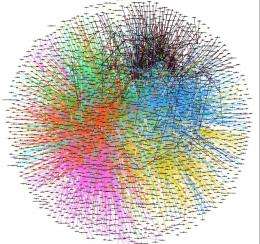October 12, 2012 report
Researchers reveal hidden patterns in flow of manuscript submissions

(Phys.org)—A research team made up of members from France, Canada and the US has been studying the manuscript submission and rejection process for biologically based papers submitted to journals for publication. They have found, as they describe in their paper published in the journal Science, that papers resubmitted and accepted by one journal after being rejected by another, receive more citations than other papers.
To find out more about the submission, rejection and resubmission process, the team looked at biologically oriented submissions to 923 science journals during the years 2006 to 2008. Data was obtained by sending emails to more than 200,000 people listed as corresponding authors on published papers. Each was asked if the paper they'd published had been resubmitted to the journal that had published it, and if so, which one had previously rejected it. The team received 80,000 response emails.
In calculating statistics based on answers provided by respondents, the team found that approximately 75 percent of papers printed had not been resubmitted, a sign that work also goes into targeting submissions appropriately. For the 25 percent of papers that had been resubmitted after being rejected, the researchers found that most followed a step down process whereby submitters first submitted to high impact journals than lower ones where they met with eventual success. It was in this group that the team found what they described as the biggest surprise, that rejected papers once published elsewhere received more citations relative to others in the same journal than did those accepted on first submission.
The researchers suggest that the higher citation rate for the resubmitted papers is likely due to reviews offered by peers, referees and editors that together result in a better paper. This indicates, they say, that perhaps the quality of papers published in scientific journals might be improved overall if more papers from first time submitters were rejected. Another possibility is that papers that go against the status quo tend to get rejected more often than those that toe the line, which would cause a bigger stir, and hence citations when eventually published.
More information: Flows of Research Manuscripts Among Scientific Journals Reveal Hidden Submission Patterns, Science, DOI: 10.1126/science.1227833
ABSTRACT
The study of science-making is a growing discipline that builds largely on online publication and citation databases, while prepublication processes remain hidden. Here, we report results from a large-scale survey of the submission process, covering 923 scientific journals from the biological sciences in years 2006–2008. Manuscript flows among journals revealed a modular submission network, with high-impact journals preferentially attracting submissions. However, about 75% of published articles were submitted first to the journal that would publish them, and high-impact journals published proportionally more articles that had been resubmitted from another journal. Submission history affected postpublication impact: Resubmissions from other journals received significantly more citations than first-intent submissions, and resubmissions between different journal communities received significantly fewer citations.
Journal information: Science
© 2012 Phys.org

















